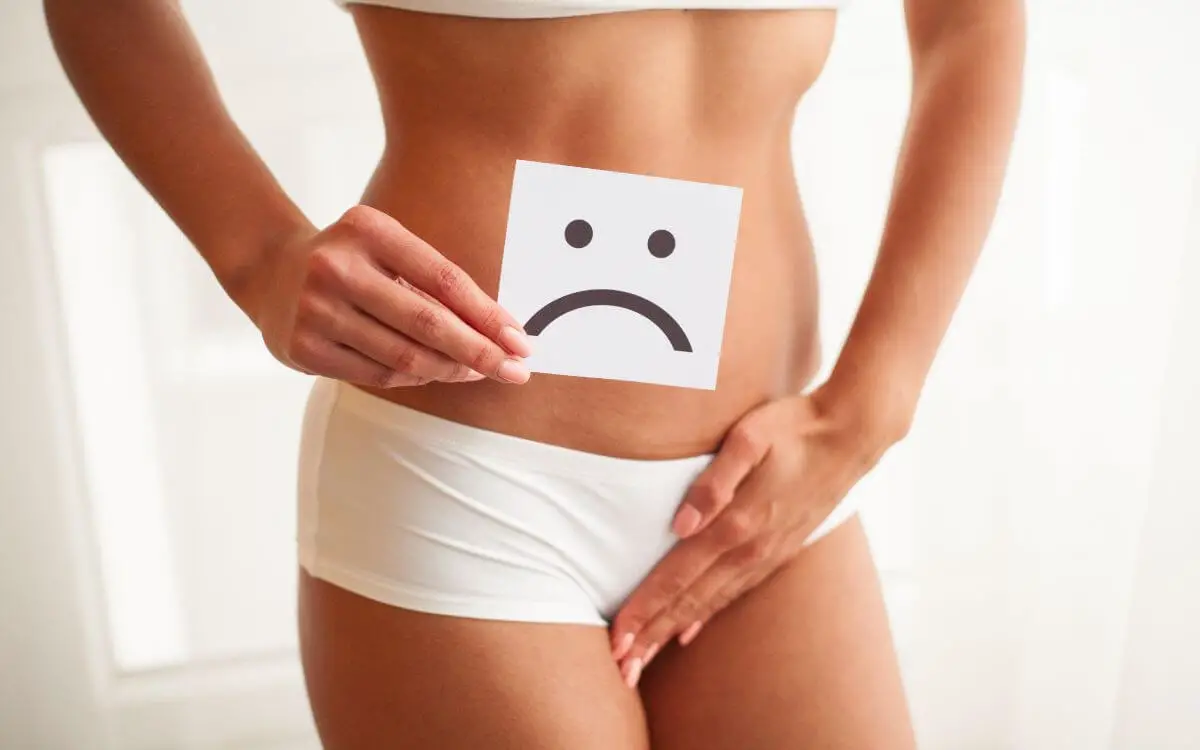Sudden Stabbing Pain in Pelvic Area in Female
Sudden stabbing pain in pelvic area female related can be a symptom of various conditions, ranging from menstrual cramps, IBS, uterine fibroids, and ovarian cysts to more serious issues like ectopic pregnancy or pelvic inflammatory disease. Today I want to focus on one that is close to my heart.
Regardless of the reason, it is crucial to seek medical evaluation to determine the underlying cause if it causes you pain and fear.
In the section below the table of contents, I provide you with more causes of pain in the pelvic area, but since my blog is about two chronic conditions my wife suffers from, I want to focus on endometriosis.
Why endo?
Because my wife was diagnosed with it. She has stage 4 endometriosis, which causes her severe pain in the pelvic area, sudden stabbing pelvic pain, severe abdominal pain, ovulation pain, bladder pain, and pain with bowel movements. Her endometriosis is deeply infiltrating, meaning, that her chronic symptoms are worse than those of stages I and II, and it causes her stabbing pain when pooping during the period.
Endometriosis can cause sudden stabbing pain in the pelvic area in females due to the growth of endometrial tissue outside of the uterus. This can cause inflammation, irritation, and scarring, leading to pain during menstruation, ovulation, and sexual activity.
In this post, I explain this in more detail…
- Causes of Pain in the Pelvic Area in Females
- An Overview of Sudden Stabbing Pain in Pelvic Area Female
- Understanding Pelvic Pain Symptoms and Potential Urgency
- When to Consider Pelvic Pain as a Signal for Immediate Medical Attention?
- The Intricacies of Endometriosis and its Association with Pelvic Pain
- Ovarian Cysts and the Risk of Sharp Pain in Lower Abdomen
- Pelvic Inflammatory Disease (PID) and Acute Pelvic Discomfort
- Pregnancy-Related Pelvic Pain
- Gynecological Conditions Beyond Endometriosis Causing Pelvic Pain
- Non-Gynecological Sources of Sudden Sharp Pain in Pelvic Region
- Female Pelvic Pain Diagnosis
- Pelvic Pain Treatment Options
- Acute Pelvic Discomfort
- Stabbing Sensations in Pelvis
- Living with Chronic Pelvic Pain
- Empowering Females Through Education on Pelvic Pain
- Final Word on Sudden Stabbing Pain in Pelvic Area Female
- Source Links for Sudden Stabbing Pain in Pelvic Area Female
Causes of Pain in the Pelvic Area in Females
Pelvic pain can be caused by a variety of conditions and factors, and it’s not always easy to pinpoint the exact cause. Some of the common causes of pelvic pain in women include:
- Pelvic Inflammatory Disease (PID).
- Urinary tract infections (UTIs).
- Ovarian cysts.
- Ectopic pregnancy.
- Endometriosis.
- Pelvic floor dysfunction.
- Vaginal infections.
- Fibroids.
- Bowel problems.
It’s important to note that pelvic pain can also be caused by psychological factors such as stress, anxiety, or depression.
In some cases, the exact cause of pelvic pain may not be clear, and it may be labeled as “chronic pelvic pain” or “chronic pelvic pain syndrome”. If you are experiencing pelvic pain, it’s important to see a healthcare provider to determine the cause of it and appropriate treatment.
Other causes of sudden stabbing pain in the pelvic area.
While endometriosis is a common cause of sudden stabbing pain in the pelvic area, there are other conditions that can cause this symptom as well. These include:
- Pelvic inflammatory disease (PID): An infection of the female reproductive organs that can cause severe pain in the pelvic area
- Ruptured ovarian cyst: A fluid-filled sac that forms on the ovary and can rupture, causing sudden and severe pain in the pelvic area (pelvic pain in women)
- Ectopic pregnancy: A pregnancy that develops outside of the uterus, often in the fallopian tubes, which can cause sharp pelvic pain and vaginal bleeding
- Sexually transmitted infections (STIs): Infections such as chlamydia or gonorrhea can cause pelvic pain and other symptoms
- Urinary tract infection (UTI): Infections in the bladder or urinary tract can cause pain in the pelvic area
- Pelvic abscess: An accumulation of pus in the pelvic area, which can cause sharp pain and other symptoms
- Round ligament pain: A common condition during pregnancy in which the ligaments that support the uterus stretch and cause pain in the pelvic region
- Vaginal bleeding: Bleeding from the vaginal area can be a sign of several different conditions, including endometriosis, fibroids, or infection.
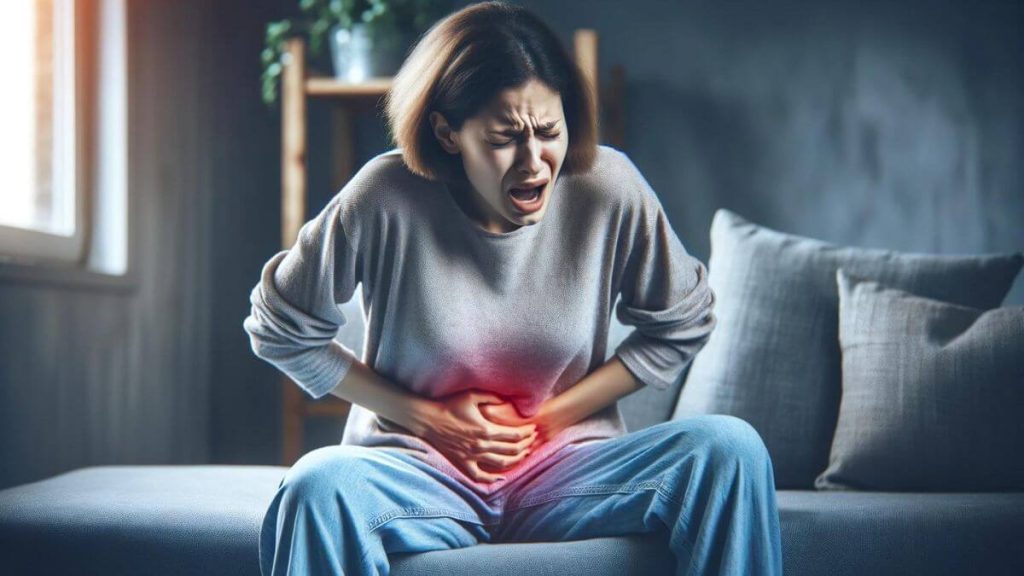
An Overview of Sudden Stabbing Pain in Pelvic Area Female
When you suffer from sudden stabbing pain in the pelvic area in females, it could be the herald of several possible health concerns that may range from benign to serious. It’s a discomfort that requires attention and understanding of the potential causes behind such acute pelvic discomfort. Many ailments, some of which are common and others less so, could explain why you are experiencing sharp pain in the lower abdomen or stabbing sensations in the pelvis.
From a clinical perspective, these pains can indicate conditions that might only cause transient discomfort or others that necessitate immediate and thorough medical examination. Recognizing the nuances between an innocuous cause and a pressing medical emergency could be vital.
Note that these conditions vary greatly in terms of severity and the kind of treatments they require. Ovarian cysts, for instance, are not uncommon and can cause sharp pain when they rupture, but they often resolve without treatment. Conversely, an ectopic pregnancy — presenting with sharp pain typically on one side of the pelvic area — is a medical emergency requiring swift intervention to prevent life-threatening complications.
While enduring stabbing pelvic pain might be frightening, understanding what symptoms to watch for can empower you to make informed decisions about your health. Remember that alongside any pelvic pain, if symptoms such as excessive bleeding, fainting, or fever are present, seek medical care immediately. Taking charge of your health means recognizing when something isn’t right and taking timely steps to address it.
With this overview of the possible causes of stabbing pain in your pelvis, you can begin to navigate the steps toward diagnosis and relief. Do not dismiss persistent or excruciating pain; seek the advice of a healthcare provider to understand it.
Here is a closer examination of the conditions that may be underlying this type of pain.
| Condition | Description | Typical Symptoms | Urgency Level |
|---|---|---|---|
| Ovarian Cysts | Fluid-filled sacs on the ovaries | Intermittent pelvic pain, bloating, pain during intercourse | Monitor; seek help if pain is severe |
| Endometriosis | Tissue like the uterine lining grows outside the uterus | Pain exacerbated during menstruation, infertility, heavy menstrual bleeding | Seek medical evaluation for management |
| Ectopic Pregnancy | Fertilized egg grows outside the uterus | Sharp stabbing pelvic pain, vaginal bleeding, dizziness | Immediate emergency medical attention |
| Urinary Tract Infections (UTIs) | Infections of the urinary system | Acute pelvic discomfort, frequent urination, burning sensation when urinating | Consult a doctor if symptoms persist |
| Musculoskeletal Issues | Problems with muscles and connective tissue | Variable pelvic pain, often related to physical activity | Medical evaluation if pain is recurring or severe |
Understanding Pelvic Pain Symptoms and Potential Urgency
When you encounter pelvic pain symptoms, it can be a disconcerting experience. Your understanding of these signals can play a pivotal role in identifying the nature and urgency of the condition. While not every situation demands immediate medical action, knowing when and how to respond to severe pelvic pain is critical for your health and well-being.
Identifying the Nature of Your Pelvic Discomfort
Various terms describe pelvic pain symptoms—some women might report it as a dull ache, others as chronic pelvic pain that lingers over time, and some could detail sharp, sudden bursts of pain. The causes of pelvic pain in women are numerous, ranging from menstrual cramps to more serious medical conditions.
To discern the potential reasons for your pain, consider factors like duration, location, and related symptoms that accompany your pelvic discomfort.
When to Consider Pelvic Pain as a Signal for Immediate Medical Attention?
Severe pelvic pain, especially if it’s sudden and unexpected, should be taken seriously. It could indicate something as urgent as a ruptured ovarian cyst, or an ectopic pregnancy—a condition considered a medical emergency.
Look out for additional warning signs such as fever, faintness, or vaginal bleeding, which further suggest the need for a prompt female pelvic pain diagnosis.
Pelvic Inflammatory Disease (PID), for instance, could manifest as acute stabbing pain with the risk of causing long-term health consequences. Monitoring the cause of your pelvic pain and its accompanying symptoms will guide you to seek the appropriate level of care without delay.
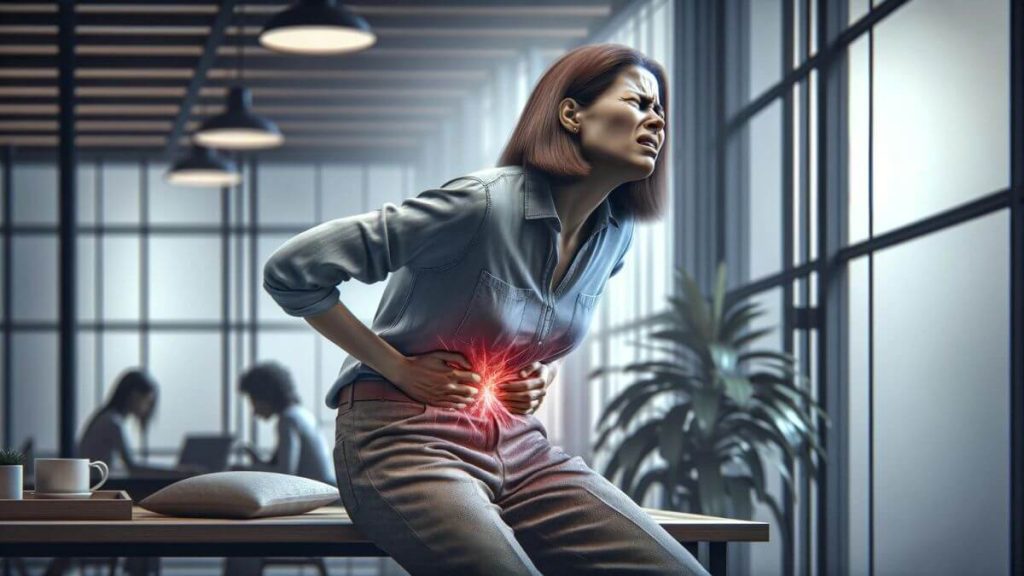
The Intricacies of Endometriosis and its Association with Pelvic Pain
Endometriosis is not just a word that resonates with discomfort; it symbolizes the complexity and the often silent struggle many women endure. It’s a perplexing condition characterized by the presence of tissue similar to the uterine lining developing outside the uterus, leading to a spectrum of symptoms, most notably, pelvic pain.
For those grappling with endometriosis, chronic pelvic pain is a common companion, and understanding this condition is integral to managing its impact on your life. As you delve into the layers of endometriosis and how it intertwines with chronic pelvic discomfort, it’s crucial to acknowledge the varied ways it manifests in the female body and the substantial implications it holds for health and fertility.
What is Endometriosis and How it Affects the Female Body?
Pelvic pain is a common complaint among women, but when it is sudden and stabbing in the pelvic area in females isn’t, it can be a sign of something serious, such as endometriosis.
Endometriosis is a condition in which the tissue that is similar to the one that normally lines the inside of the uterus grows outside of it, causing inflammation and scarring. This can lead to severe pain in the pelvic area, especially during menstruation.
Gynecological conditions like endometriosis often insinuate themselves silently, causing female reproductive system pain that extends beyond mere physiological symptoms.
It is a condition that mimics the menstrual cycle but outside the womb, creating an inflammatory response that can lead to scarring, adhesions, and profound discomfort. This chronic ailment resonates through the pelvic region, resulting in acute pain and a bevy of associated symptoms.
Progressive Impact of Endometriosis on Health and Fertility
Recognizing the progressive nature of endometriosis is crucial as it may start with seemingly innocuous symptoms but can escalate, impairing more than just the quality of life. It often leads to dyspareunia and could contribute to infertility issues, and worrying concerns for those looking to start or grow a family.
The infiltrative character of endometriosis can sometimes trigger acute medical emergencies, such as intestinal complications or pulmonary issues, necessitating prompt and informed medical response.
Being vigilant about the signs and seeking professional guidance is paramount for those of you confronted with this condition. It is a journey that requires patience, comprehensive medical support, and an indomitable spirit to navigate the ups and downs associated with this pervasive form of pelvic pain.
Ensure you’re armed with knowledge and support. Be proactive in your health and consult your healthcare provider to explore management options that offer you relief and the opportunity to reclaim control over your body and your life.
What types of pain can endometriosis cause?
The inflamed tissue from endometriosis can cause various types of pain, including:
- Sharp pelvic pain
- Dull ache
- Acute pelvic pain
- Chronic pain in one pelvic region
- Chronic pain that spreads
- Round ligament pain
- Sharp pains with ovarian cyst
- Sharp pain from a ruptured cyst
- Cramping pains (muscle spasms)
- Burning pain
- Sudden pain with bowel movements
- Lower abdomen or upper abdominal pain
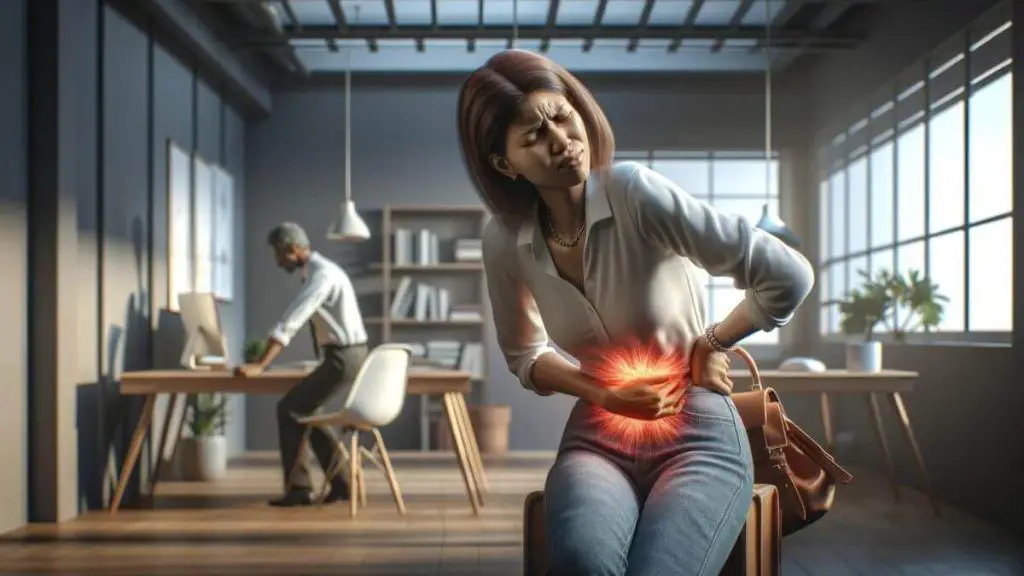
Ovarian Cysts and the Risk of Sharp Pain in Lower Abdomen
Many women may experience ovarian cysts at some point in their lives. While these cysts are typically known as benign growths that may disappear on their own, they can sometimes lead to discomfort or more acute concerns like severe pelvic pain. Understanding the implications of ovarian cysts is essential for identifying when this condition may warrant closer medical scrutiny.
Are Ovarian Cysts Harmless or Causes for Concern?
Ovarian cysts often present little to no symptoms and are discovered incidentally during routine gynecological exams. But when you feel a sharp pain in the female pelvic region, it may be a sign that a cyst has become problematic. This discomfort could be an indication that the cyst has grown, is causing the ovary to strain, or has ruptured.
A ruptured cyst may cause severe pain and internal bleeding, and in certain situations, immediate healthcare intervention is crucial.
Here are some symptoms associated with ovarian cysts that you should be aware of:
- Swelling or bloating in the abdomen
- Dull ache in the lower back
- Pain during intercourse
- Irregular menstrual cycles or unusual bleeding
- A feeling of fullness or heaviness in the abdomen
Understanding Ovarian Torsion and Its Consequences
Ovarian torsion is a serious condition where a cyst causes the ovary to twist, potentially impeding blood flow to the ovary and leading to a medical emergency.
Recognizing the signs of this condition is vital. Ovarian torsion usually manifests as sudden, severe pelvic pain on one side of the body, often accompanied by nausea and vomiting. If you experience these symptoms, it is essential to seek medical attention immediately to avoid irreversible damage to the ovarian tissue.
Should you be at risk for ovarian torsion, here’s what to look out for:
- Sharp, piercing pelvic pain suddenly occurs on one side
- Abdominal pain dissipates and then returns with increased intensity
- Nausea and, or vomiting
- Rapid heartbeat
- Fever, in some cases
Given the potential for ovarian cysts to cause significant issues, it is crucial to monitor your health and report any concerning or persistent pain to your healthcare provider. They can conduct appropriate exams and imaging tests to determine the cause of your symptoms.
Being knowledgeable about conditions like ovarian cysts and understanding when they may lead to sharp pain in the lower abdomen empowers you to make informed decisions about your health. If you are dealing with these symptoms or have concerns about ovarian cysts, don’t hesitate to consult your doctor for guidance and care tailored to your individual needs.
Pelvic Inflammatory Disease (PID) and Acute Pelvic Discomfort
When confronted with acute pelvic discomfort, it’s essential to consider Pelvic Inflammatory Disease (PID) as a potential culprit. PID is a significant health concern that emerges from an infection of the upper genital tract, often due to sexually transmitted infections like chlamydia or gonorrhea. This condition has been linked to chronic symptoms that may contribute to fertility complications, and in some instances, trigger sudden, sharp pelvic cramps that demand immediate medical attention.
One alarming symptom associated with PID is stabbing pain when pooping during a period, a distressing experience that could point towards this intricate inflammation. Other indications of PID include severe stabbing pain that persists, fever, and signs of an infection such as an unusual vaginal discharge or overall feeling of malaise.
These symptoms should not be ignored as they could potentially lead to long-standing consequences like chronic pelvic pain and infertility if left untreated.
If you are experiencing these distressing symptoms, it’s imperative to seek prompt medical treatment. Effective management of PID often involves a course of antibiotics to combat the infection. Delay in treatment can result in complications such as the formation of scar tissue, ectopic pregnancy, or ongoing pelvic pain that can drastically affect your daily life and reproductive health.
Being proactive about your reproductive health includes recognizing the signs and symptoms of conditions like PID. Persistent acute pelvic discomfort is your body sounding the alarm. Pay attention to these warnings and take control by securing the necessary medical consultation to address your health concerns competently and compassionately.
Knowledge is your best defense. Stay informed about PID and other possible causes of pelvic pain to ensure you’re taking the right steps toward your health and well-being.
To further understand PID’s common symptoms and potential impact, take a look at the following overview…
| Common Symptoms | Possible Complications | Recommended Action |
|---|---|---|
| Stabbing pelvic pain | Chronic pelvic pain | Consult a healthcare provider |
| Fever and malaise | Infertility | Immediate medical evaluation |
| Unusual vaginal discharge | Scar tissue formation | Prescribed course of antibiotics |
Pregnancy-Related Pelvic Pain
Experiencing pelvic pain during pregnancy is not uncommon, and although often benign, some pains may signal more serious conditions. As you navigate through the different types of pregnancy-related pelvic pain, it’s vital to understand when it’s a normal part of pregnancy and when it could be a sign of something more critical, such as an ectopic pregnancy.
Round Ligament Pain
As your body adapts to accommodate a growing baby, you may notice round ligament pain—a sharp, stabbing pain primarily caused by the stretching of the round ligaments that support the uterus. This type of discomfort is generally considered normal and typically resolves after pregnancy.
The sensation can be particularly noticeable when you transition from sitting to standing or during sudden movements, and although intense, round ligament pain is often short-lived and not a cause for alarm.
Ectopic Pregnancy
An ectopic pregnancy, on the other hand, is a critical condition where the fertilized egg implants outside the uterus, most commonly in a fallopian tube.
This type of pregnancy can cause significant stabbing pain in the pelvic area and might additionally manifest through symptoms like missed periods, pain on one side of your body, or a sharp pain in the shoulder. If you experience any signs of an ectopic pregnancy, it is crucial to seek immediate medical care to prevent the risk of life-threatening issues such as internal bleeding.
Recognizing the symptoms that accompany different types of pregnancy-related pelvic pain can significantly influence the steps you take toward managing your well-being. Should you notice a stabbing pain in your bum when on period or if you encounter other concerns such as ectopic pregnancy signs, consult with your healthcare provider to ensure both your safety and that of your baby?
While round ligament pain is typically a benign, albeit uncomfortable, aspect of pregnancy, paying attention to your body’s signals is always essential. Don’t hesitate to reach out for assistance if your discomfort escalates or if symptoms align with those of an ectopic pregnancy. Professional medical guidance is key to managing pregnancy-related pelvic pain effectively and ensuring the best possible outcome for you and your little one.
| Type of Pain | Characteristics | Management Considerations |
|---|---|---|
| Round Ligament Pain | Stabbing or sharp pain; triggered by movement | Observation; pain relief methods like rest and gentle movements |
| Ectopic Pregnancy Pain | Intense stabbing pain; accompanied by other symptoms like vaginal bleeding | Emergency medical attention; potential surgical intervention |
Gynecological Conditions Beyond Endometriosis Causing Pelvic Pain
While endometriosis is a well-known cause of pelvic discomfort, many other gynecological conditions could be the source of your symptoms. Ranging from usual suspects like fibroids and menstrual cramps to the more serious pelvic inflammatory disease, understanding the wide array of issues is essential.
Let’s shed light on other possible causes of stabbing pain in the private area and how you might approach pelvic pain treatment.
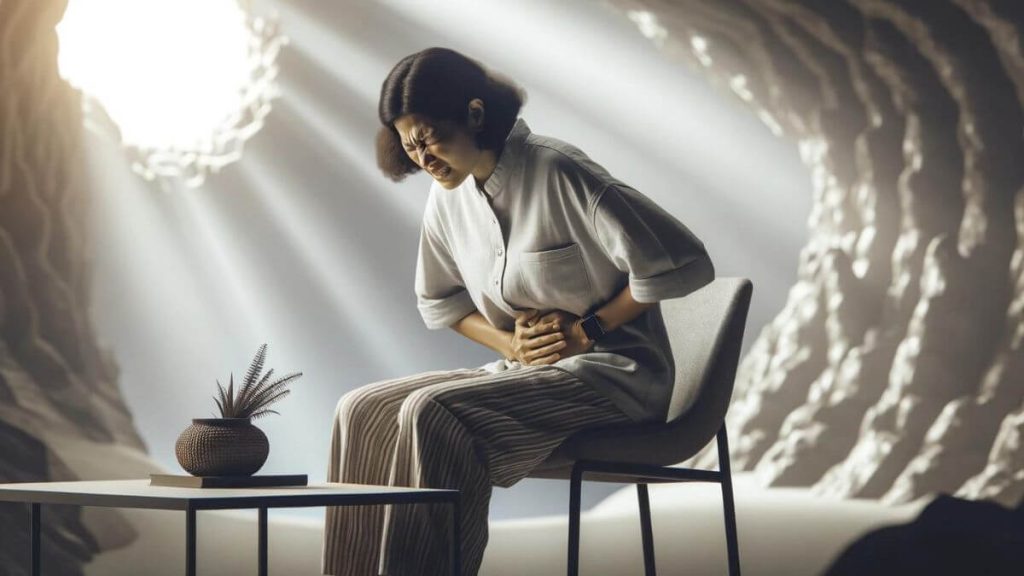
Pelvic Inflammatory Disease
Pelvic Inflammatory Disease (PID) encompasses a group of infections that can cause extensive damage to your reproductive organs. Not limited to simply causing sharp pain in the female pelvic region, PID may escalate to chronic health problems if not addressed promptly and effectively. Symptoms like intense cramping, unusual discharge, and pain during sexual activities are telltale signs you need to look out for.
Understanding the Different Facets of Gynecological Pain in Females
Gynecological conditions leading to pelvic pain might manifest in various forms. Some might give rise to an occasional discomfort, while others can become persistently debilitating. Severe pelvic cramps that disrupt your daily life or interruptions your menstrual cycle with abnormal bleeding patterns are clear indicators that it’s time to consider pelvic pain treatment options.
Assessing and managing gynecological issues often involves a multifaceted approach:
- Treatment through medication or surgical procedures
- Lifestyle modifications to ease symptoms and prevent aggravation
- Regular check-ups to monitor the condition and adjust treatments accordingly
Remember, gynecological conditions and pelvic pain are not just about physical discomfort; they impact your overall quality of life and mental well-being. Therefore, it’s imperative that you advocate for your health by seeking medical advice early when you notice symptoms like a sharp pain in the female pelvic region or stabbing pain in the private area.
Non-Gynecological Sources of Sudden Sharp Pain in Pelvic Region
While many might associate sudden sharp pain in the pelvic region with gynecological issues, it’s important to be aware that non-gynecological factors can also be significant contributors. Understanding these potential sources is key, as they may require different diagnostic approaches and treatment strategies compared to their gynecological counterparts.
The Role of Urinary Tract Infections in Causing Sudden Pelvic Pain
One of the common non-gynecological causes of pelvic discomfort is a urinary tract infection (UTI), which can lead to sharp pelvic cramps and extreme discomfort. A UTI occurs when bacteria invade the urinary system, leading to an infection that can cause sudden sharp pain in the pelvic region.
Alongside pain, you might also experience symptoms such as a burning sensation during urination or a frequent need to urinate. These infections are generally treated with antibiotics, but it’s crucial to consult your healthcare provider for an accurate diagnosis and appropriate treatment plan.
Muscle Pain and Other Soft Tissue Causes of Pelvic Discomfort
Another source of non-gynecological pelvic pain can stem from muscle pain or musculoskeletal conditions. Soft tissue issues such as muscle strains, spasms, or injuries in the pelvic area may lead to intermittent or continuous pelvic discomfort.
The pain may vary from a dull ache to sharp, shooting pains that disrupt daily activities. Treatment for musculoskeletal-related pelvic pain often includes rest, appropriate pain relievers, and in some instances, physical therapy. If muscle pain persists, it’s important to reach out to your healthcare provider to rule out any underlying conditions and to receive targeted treatment.
Your understanding of the full span of potential causes for pelvic pain can aid in seeking timely medical intervention and finding relief. Knowing whether the pain emanates from a UTI or from muscular issues means that you can communicate effectively with your healthcare provider and embark on the appropriate course of treatment.
Female Pelvic Pain Diagnosis
When you’re facing pelvic pain symptoms, the journey towards a female pelvic pain diagnosis begins with a detailed medical evaluation. The complexity of pelvic pain diagnosis lies in the multitude of potential causes—ranging from benign menstrual cramps to more serious conditions, such as sudden stabbing pain in the pelvic area in females that may signify an underlying health issue.
Recognizing the need for a methodical approach to address your discomfort, healthcare professionals deploy a variety of tests and exams designed to uncover the root cause of pelvic pain. The goal is to provide you with an accurate diagnosis so that an effective treatment plan can be established.
The Diagnostic Process for Identifying Causes of Pelvic Pain
The first step in diagnosing pelvic pain symptoms is often a thorough history and physical examination. Your provider will inquire about the nature, timing, and location of your pain to distinguish between gynecological and non-gynecological sources. They’ll explore your medical history, surgical background, and any recent activities that may contribute to your condition.
Key Tests and Exams for a Comprehensive Female Pelvic Pain Evaluation
To refine the scope of potential causes, a range of diagnostic tests may be employed. These can include:
- Pelvic Ultrasound: This non-invasive imaging test provides detailed images of the pelvic organs, which can help identify structural abnormalities, such as ovarian cysts or uterine fibroids.
- CT Scan: Offering cross-sectional views of your body’s internal structures, CT scans can detect pelvic organ conditions, appendicitis, and other non-gynecological causes of pelvic pain.
- Laparoscopy: As a minimally invasive surgical procedure, laparoscopy allows for direct visualization of the pelvic organs and can aid in diagnosing conditions such as endometriosis.
- Pelvic Exam: A hands-on assessment might reveal tenderness, masses, or anatomical abnormalities in the pelvic region.
- Pap Test: While not a diagnosis tool for pelvic pain, it’s a common component of gynecological evaluations and can detect cervical changes that may require further investigation.
These tests are selected based on the likelihood of certain conditions being responsible for your pain. For instance, if you’re experiencing sudden stabbing pain in the pelvic area in females, a timely ultrasound or CT scan could be pivotal in identifying an ovarian cyst rupture or appendicitis.
Remember, the path to diagnosing and managing pelvic pain is often multidisciplinary, involving radiologists, gynecologists, and sometimes gastroenterologists or urologists. You shouldn’t hesitate to seek evaluation if you’re troubled by persistent or sharp pelvic pain. A comprehensive and compassionate approach can pave the way to relief and recovery.
Pelvic Pain Treatment Options
When it comes to pelvic pain treatment, understanding the array of options available is essential. Whether you’re dealing with sharp pain in the female pelvic region or ongoing discomfort due to gynecological conditions and pelvic pain, a personalized approach is key.
Treatment strategies can vary greatly based on the underpinning causes, ranging from pharmacological methods to surgical interventions, each tailored to your specific needs.
From Medications to Surgery
The route to alleviating pelvic discomfort may include a variety of medications, from over-the-counter pain relievers to prescription treatments. For instance, hormonal therapies like oral contraceptives are often recommended for managing conditions such as endometriosis, known for causing severe and persistent pain. In more acute scenarios where conditions like ovarian cysts prove troublesome, surgical procedures may be necessary.
Antibiotic treatments are the frontline defense against conditions like Pelvic Inflammatory Disease (PID), designed to target the infection directly. If the pain is associated with a distressing event, such as ruptured ovarian cysts, emergency surgery may be required. It’s paramount that you work closely with your healthcare provider to navigate the spectrum of interventions available and find the solution that best suits your symptoms and situation.
Chronic Pelvic Pain Management and Lifestyle Adjustments
For those grappling with chronic pelvic pain management, an integrated approach may bring much-needed relief. Lifestyle modifications, including dietary tweaks and stress reduction exercises, can complement medical treatments to improve your quality of life. Techniques such as pelvic floor physical therapy serve as another viable method to combat persistent discomfort, educating you on ways to strengthen the muscles in your pelvic region to alleviate pain.
Establishing a dialogue with your healthcare provider is indispensable for chronic pelvic pain sufferers. Together, you’ll be able to construct a tailored treatment plan that addresses both the physical and emotional aspects of your pain. Remember, chronic pelvic pain management often requires patience and persistence, but with a comprehensive treatment strategy in place, you’re paving the path toward reclaiming your comfort and well-being.

Acute Pelvic Discomfort
When you’re hit with acute pelvic discomfort or a sudden sharp pain in the pelvic region, it may be more than just a minor issue. These symptoms can signal a serious condition that requires prompt attention. It is critical to be aware of the indications that necessitate immediate medical care to reduce the risk of long-term health complications.
For instance, experiencing stabbing pain when pooping during a period or sharp pelvic cramps could point towards serious health concerns. If these pains are accompanied by other symptoms such as fever, or significant blood loss, or if they arise during pregnancy, they may indicate conditions like ectopic pregnancy that demand emergency intervention.
Do not hesitate to act if your symptoms seem to align with the more serious scenarios outlined above. Heeding these signs and seeking medical care swiftly could save your life or prevent conditions from progressing to more severe stages.
As you listen to your body’s signals, keep in mind that acute pelvic discomfort can be a red flag for conditions necessitating urgent medical attention. It’s always better to be safe and consult with healthcare professionals who can provide a precise diagnosis and the appropriate treatment path.
Remember, early intervention is key when dealing with any form of sudden sharp pain in the pelvic region. Your health is paramount and understanding when to seek urgent care is vital for your present and future well-being.
Below is a guide to help you identify symptoms associated with acute pelvic pain that should not be ignored…
| Symptom | Possible Cause | Action Needed |
|---|---|---|
| Sudden, sharp pelvic pain | Could signal ovarian issues or ectopic pregnancy | Immediate medical evaluation |
| Stabbing pain during bowel movements | May be associated with endometriosis or pelvic inflammatory disease | Doctor’s visit advised |
| Sharp pelvic cramps | Could be an indicator of ruptured cysts or severe infection | Urgent care or ER visit |
| Fever alongside pelvic pain | Sign of infection, potentially from an STI leading to PID | Seek medical attention promptly |
Stabbing Sensations in Pelvis
Experiencing stabbing sensations in the pelvis can be unsettling, especially when it accompanies other symptoms such as painful bowel movements during a period or more general gynecological pain in females. These symptoms could be indicative of a range of underlying gynecological disorders that warrant a thorough examination to accurately diagnose and address the causes.
The Connection Between Painful Bowel Movements During Period and Gynecological Issues
One symptom that often raises concerns is experiencing painful bowel movements during a period. This discomfort can signal conditions like endometriosis, where endometrial-like tissue grows outside the uterus, causing inflammation and scar tissue. This can affect the bowels, especially during menstruation, leading to pain and discomfort.
Stabbing Pain During Period
Similarly, stabbing pain during a period could point towards other serious gynecological disorders like ovarian cysts. These fluid-filled sacs can cause sharp pelvic pain when they rupture or twist, known as ovarian torsion, which is a medical emergency necessitating urgent intervention.
It is crucial to approach a healthcare provider if you’re experiencing stabbing sensations in the pelvis or other indications of a gynecological issue. Timely medical attention can help in managing symptoms and preventing long-term complications associated with conditions like endometriosis and ovarian cysts.
Your provider may recommend tests such as ultrasounds or laparoscopy to visualize the condition and decide on the best course of treatment, which may include medication, lifestyle changes, or surgery.
Understanding that these stabbing sensations could be a sign of deeper gynecological problems is the first step towards taking active control of your health. With proper diagnosis and management, you can significantly alleviate your pain and improve your quality of life.
| Disorder | Common Symptoms | Complications | Treatment Options |
|---|---|---|---|
| Endometriosis | – Painful bowel movements – Chronic pelvic pain – Heavy menstrual bleeding | – Infertility – Ovarian cysts | – Hormone therapy – Pain management – Surgical options |
| Ovarian Cysts | – Sudden sharp pelvic pain – Bloating – Irregular periods | – Ovarian torsion – Cyst rupture | – Monitoring – Birth control pills – Surgical removal |
Living with Chronic Pelvic Pain
Enduring chronic pelvic pain can be a personal journey marked by challenges both physical and emotional. If you live with this discomfort, it’s crucial to discover ways to manage the pain and minimize its impact on your daily life.
This involves a combination of adapting lifestyle habits, exploring various pain management methods, and seeking emotional support to navigate the complexities of chronic pelvic conditions.
Adapting Your Lifestyle to Manage Chronic Pelvic Pain
Managing chronic pelvic pain often begins with lifestyle changes aimed at alleviating symptoms. You might modify your diet to eliminate foods that could potentially aggravate your condition, and embrace a well-rounded exercise routine designed to strengthen the pelvic floor muscles. Incorporating heat therapy can also offer respite from pain, and you might explore options like warm baths or heating pads. Below is a list that summarizes lifestyle adaptations for managing severe pelvic pain:
- Follow an anti-inflammatory diet to reduce pain triggers.
- Engage in low-impact exercises, such as swimming or yoga, to maintain flexibility and core strength.
- Utilize heat therapy like warm baths or heated cushions to ease muscle tension.
- Adopt relaxation techniques, including meditation and deep breathing, to reduce stress-induced pain.
Nurturing Mental and Emotional Well-being
It’s not unusual for chronic pain to take a toll on your mental and emotional health. As you deal with the daily realities of coping with chronic pelvic conditions, seeking support from mental health professionals or joining support groups can be vital.
Communicating your experiences with others facing similar challenges can foster a sense of community and understanding. Establishing a trusted relationship with healthcare providers is also essential for personalizing your care, ensuring it addresses both the emotional and physical aspects of enduring chronic pelvic pain.
Remember, chronic pelvic pain management is not a one-size-fits-all solution. It may take time to find the right combination of therapies and support. Here’s a practical outline of methods to bolster your mental and emotional well-being:
- Consider therapy or counseling to address the psychological impact of chronic pain.
- Participate in support groups where you can share your experiences and learn from others.
- Explore mindfulness or stress-reduction programs that can complement medical treatments.
- Stay connected with friends and family who can provide emotional support.
Chronic pelvic pain doesn’t have to define your existence. With the right strategies and a network of care, you can take meaningful steps to manage your condition and maintain a fulfilling life. Talk with your healthcare provider about crafting a tailored plan that suits your unique situation and start paving the way towards pain management that supports your overall well-being.
Empowering Females Through Education on Pelvic Pain
Proper understanding and management of female reproductive system pain are fundamental steps in affirming one’s health. Educating yourself about the various conditions that cause pelvic pain is a proactive measure that not only enlightens but empowers.
It allows you to distinguish between general discomfort and symptoms that may require immediate medical attention.
By elevating pelvic pain awareness, you are better equipped to engage in informed conversations with healthcare providers and make decisions that are right for your body.
Elevating Awareness of Conditions Associated with Female Reproductive System Pain
Awareness is the first step towards change. By raising pelvic pain awareness, females are encouraged to listen and respond to their bodies with greater understanding.
Knowledge about conditions such as endometriosis, ovarian cysts, and Pelvic Inflammatory Disease (PID) can be the difference between suffering in silence and seeking earnest solutions. When you recognize the early signs and symptoms of these conditions, you’re positioned to seek timely intervention and preventative care, alleviating potential risks and complications.
Fostering a Supportive Community for Women Experiencing Pelvic Pain
In your journey through managing pelvic pain, remember that you’re not alone. Building a supportive community for pelvic pain can provide solace and strength. Sharing experiences, insights, and encouragement within groups and forums creates a network where women feel heard and empowered.
By advocating for health education and standing together, this network amplifies the collective voice, advancing the cause for effective treatment and research. As a member of this proactive group, your experiences contribute to a larger narrative of empowerment and healing for all females grappling with pelvic pain.
Final Word on Sudden Stabbing Pain in Pelvic Area Female
Severe pelvic pain, sudden stabbing pelvic pain, and stabbing pain when pooping during the period, all can be symptoms of endometriosis. Other symptoms include painful periods, painful intercourse, and infertility.
Treatment options for endometriosis often include pain relievers, hormonal therapy, therapy, and alternative therapies.
While the holistic approach is very good because doesn’t cause side effects, surgery is the last hope to reduce pelvic pain in women, get rid of an ovarian cyst, especially a ruptured ovarian cyst, and help lower the volume of abdominal pain.
I explore more stabbing pain when pooping during a period in the very post I just mentioned. My wife suffers terribly, especially because one of her ovarian cysts is stuck to her uterus.
This cannot be mistaken for other things than endometriosis because endometriosis risk of endometriomas and ovarian cysts is high.
If the cyst is large or causes serious symptoms, such as severe pain, bleeding, or rapid growth, emergency surgery may be necessary.
During surgery, the doctor will remove the cyst and any surrounding tissue that is affected.
It is important to follow the doctor’s instructions for recovery and to attend all follow-up appointments. In some cases, a woman may need additional treatment or monitoring to ensure that the cyst does not return or cause further complications.


About Me
Hi, I’m Lucjan! The reason why I decided to create this blog was my beautiful wife, who experienced a lot of pain in life, but also the lack of information about endometriosis and fibromyalgia for men…
